InstaCart Statistics By Revenue, Users, Sales And Facts (2025)
Updated · Sep 13, 2025
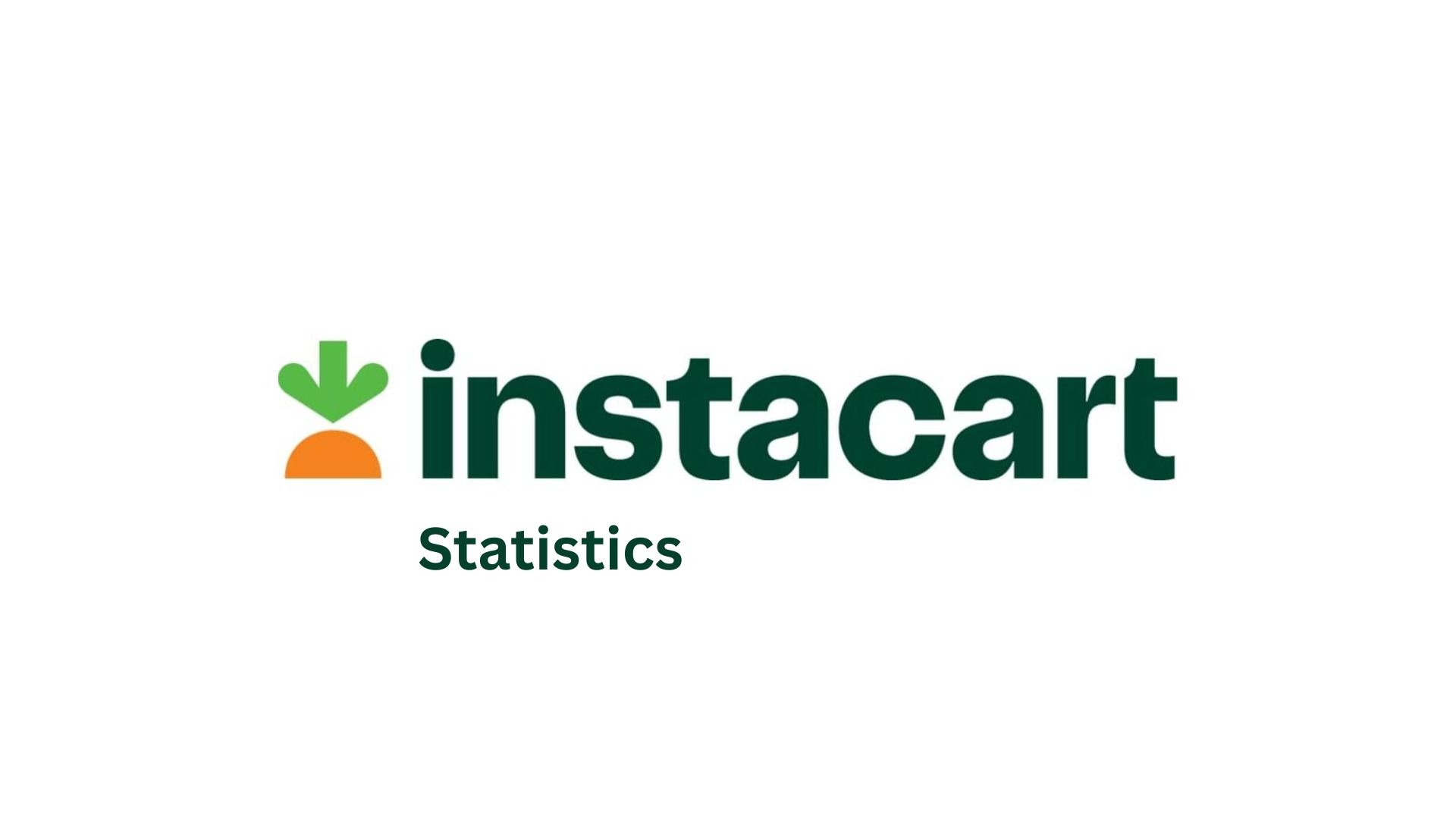
Table of Contents
Introduction
Instacart Statistics: Instacart remained a key player in online grocery shopping throughout 2024, steadily expanding its marketplace and solidifying its position in the digital retail space. The company added new retail partners, expanded its advertising business, and maintained its profitability, demonstrating that its business model remains effective. Instacart has become an essential link between grocery retailers and customers, offering convenience through fast delivery and pickup options.
Its platform not only connects shoppers to a wide selection of stores but also helps retailers increase sales through digital visibility and advertising tools. With its ongoing expansion and consistent performance, Instacart is shaping the future of grocery shopping by combining technology, retail partnerships, and customer demand into a unified service. This article will discuss the Instacart statistics and its financial aspects.
Editor’s Choice
- The growth of Instacart’s ad business is very bullish, with an estimated US$1.18 billion of ad revenues in 2024, marking the first time ad revenues surpass US$1 billion, and a 25.5% increase over 2023.
- Between 2021 and 2025, the earned increment of US$900 million in ad revenues marks a 163.6% increase in ad revenues, with a 27.5% average annual growth rate.
- There continues to be adoption of the platform, as evidenced by the increase in Instacart users, from 3.3 million in 2017 to a projected 14.9 million in 2025.
- On average, the platform completes 9 orders every second, or close to 258 million orders yearly, demonstrating the enormity of Instacart’s operations.
- In the height of the pandemic, Instacart’s revenue increased from US$0.71 billion to US$23.42 billion within a year. This figure is predicted to almost double, reaching US$40.54 billion in 2024.
- The number of orders placed grew from 223 million in 2021 to a projected 312 million in 2025, indicating strong and steady demand as well as habitual use by customers.
- From 2017 to 2023, Instacart’s retail partnerships grew from 165 partners to over 1,200, enabling the company to service approximately 80,000 stores throughout North America.
- The company’s valuation has seen major shifts, hitting US$39 billion in 2021, and adjusting to US$8.9 billion in 2024, with a forecast of US$8.4 billion in 2025, suggesting the post-pandemic market.
- Instacart’s growth is enabled by a subscription model (Instacart+), solid advertising income, and retailer partnerships, which allow it to maintain a balance between growth and profitability.
General Facts
- Instacart operates as the top grocery delivery service in both the U.S. and Canada, integrating grocery retail services with technology.
- In Q3 of 2024, Instacart earned over US$850 million in revenue, which is an increase in revenue since its public listing in September 2023.
- Instacart was one of the first companies to offer on-demand grocery delivery services in the U.S., and successfully weathered the barrage of competitors after the outbreak of COVID-19.
- In 2023, Instacart’s annual revenue surpassed US$3 billion, still lagging behind the leading food delivery companies, DoorDash and Uber Eats.
- Amazon Fresh, Walmart, and Shipt are other notable competitors in the grocery and convenience delivery sector.
- A Statista report from September 2024 on Instacart statistics revealed that 54% of the U.S. online grocery shoppers used Walmart, 40% used Amazon Fresh, and Instacart, along with Costco, was in the third position with 22%.
- The acquisitions and market withdrawals in the post-pandemic recession resulted in the decline of competitors in the online grocery industry.
- The remaining companies in the space are engaging in competition for retention through subscription-based models, while attempting to consolidate their market share.
- Instacart’s subscription offering, Instacart+, removes delivery charges and per-order fees, promoting more frequent purchases, even smaller ones, from paying customers.
- The subscription service is useful for customer retention, as it makes it less likely for them to use Amazon Fresh or Walmart.
- By October 2024, 9% of the United States’ online grocery shoppers opted for Instacart+, which is less than both the 25% of Walmart+ users and the 11% of DashPass users.
- Instacart manages to maintain growth together with profitability by utilising both its subscription model and its advertising business.
- Winning in the food delivery business today is a constant balancing act of fully serving the customer, keeping loyalty programs, and subscription incentives strong.
InstaCart Revenue
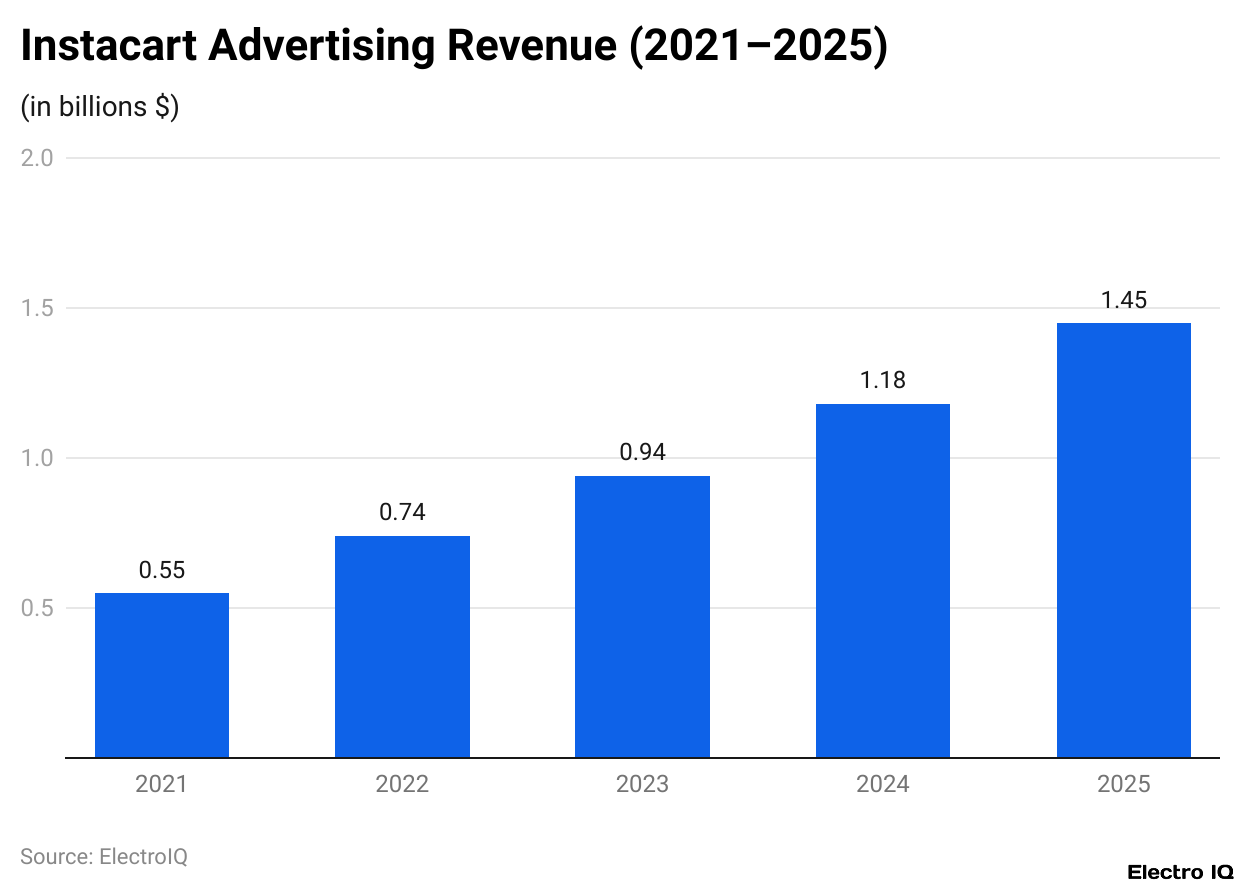
(Reference: oberlo.com)
- A recent analysis highlights that in 2024, Instacart’s advertising revenues will hit US$1.18 billion, marking the first time the company will surpass the US$1 billion milestone.
- The figure represents a 25.5% increase from 2023, though it also marks a slight slowdown compared to previous years’ growth.
- In 2023, Instacart went public and stated that its Ads platform reached 7.7 million shoppers and was used by 5,500 brands.
- In the same year, ad revenues advanced 27% to US$940 million, following a 34.5% jump the year before to US$740 million.
- Instacart’s ad revenues went back to US$550 million in 2021, so the company more than doubled this revenue in five years, maintaining an average growth rate of 29% a year.
- Analysts are optimistic that Instacart’s advertising venture will continue growing, albeit at a marginally slower rate.
- The ad revenues for 2025 are forecasted to grow by 23% and reach US$1.45 billion, which is 2.5 percentage points less than the growth projected for 2024.
- From 2021 to 2025, Instacart’s ad revenue is expected to earn an additional US$900 million, which is an overall growth of 163.6% and an average annual growth of 27.5%.
- The best annual growth was in 2022, while the worst is expected in 2025.
InstaCart Annual Users
| Year |
Users ( in mm)
|
| 2017 | 3.3 |
| 2018 | 4.3 |
| 2019 | 5.5 |
| 2020 | 9.6 |
| 2021 | 11.1 |
| 2022 | 13.7 |
| 2023 | 14 |
| 2024 |
14.4 (Updated 6th May 2025)
|
| 2025 (Estimated) | 14.9 |
(Source: prioridata.com)
- As per Priordata, Instacart statistics state that in 2017, Instacart began with 3.3 million users, and a year later, that number rose to 4.3 million users.
- By 2019, the platform boasted 5.5 million users, and that number nearly doubled to 9.6 million during the pandemic-induced online grocery shopping boom of 2020.
- The numbers continued to rise in 2021, with 11.1 million users, followed by a 25% growth in 2022, resulting in an overall user count of 13.7 million.
- After that, the overall number has remained steady, although growth has slowed down. Instacart had approximately 14 million users in 2023.
- In 2024, it rose marginally to 14.4 million. With updated estimates in May 2025, Instacart’s user count will be around 14.9 million.
- This illustrates that although the peak growth is behind the company, steady gains are still being made year after year.
InstaCart Advertising Revenue
- As per Oberlo, Instacart statistics show that the market analysts anticipate a continued increase in Instacart’s advertising revenues in 2025, albeit at a slightly reduced rate.
- Compared to the 25.5% growth in 2024, ad revenues are expected to increase by 23% in 2025, reaching US$1.45 billion.
- Putting it into context, Instacart’s ad revenues are expected to increase by US$900 million from 2021 to 2025.
- This US$900 million growth represents a 163.6% overall increase, with a 27.5% average growth each year.
- The highest revenue growth in a year was in 2022, and the lowest is projected to happen in 2025, signalling a steady decline in growth rate.
- Additional revenues are expected to continue increasing.
InstaCart Order Volume
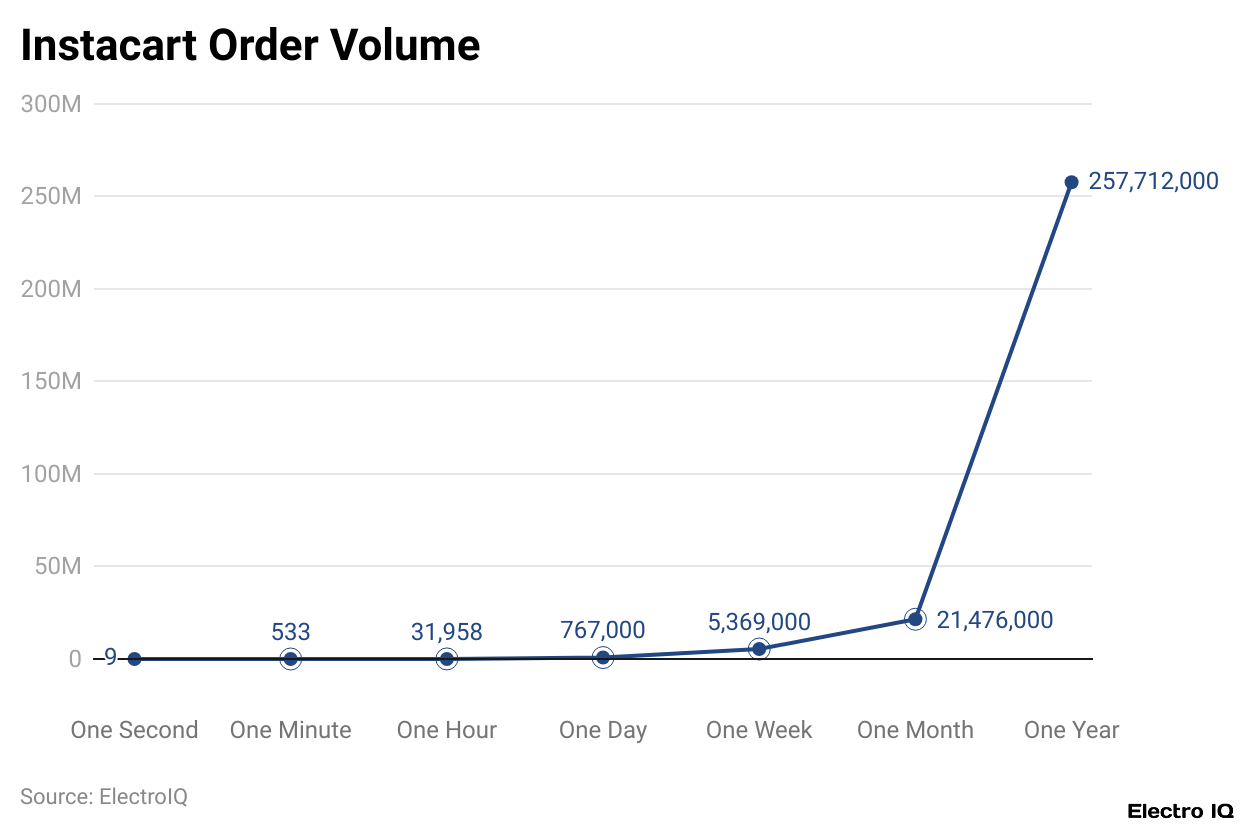
(Reference: prioridata.com)
- At the same time as Instacart processes orders, Instacart processes an estimated nine orders per second, which is 533 orders every 60 seconds.
- That order rate grows to roughly 31,958 every 3600 seconds, and roughly 767,000 orders are processed in a full 24 hours.
- Over a week, Instacart completes approximately 5.37 million orders, over a month 21.5 million, and in about a year, they complete roughly 258 million orders.
- For the purposes of Instacart’s online grocery shopping service, which is available in the U.S. and Canada, these statistics demonstrate the magnitude of operations that the service covers.
- Instacart’s deep integration with the daily shopping routines of millions of families is indicated by these figures, ranging from mere seconds to annual order counts.
Instacart Sales
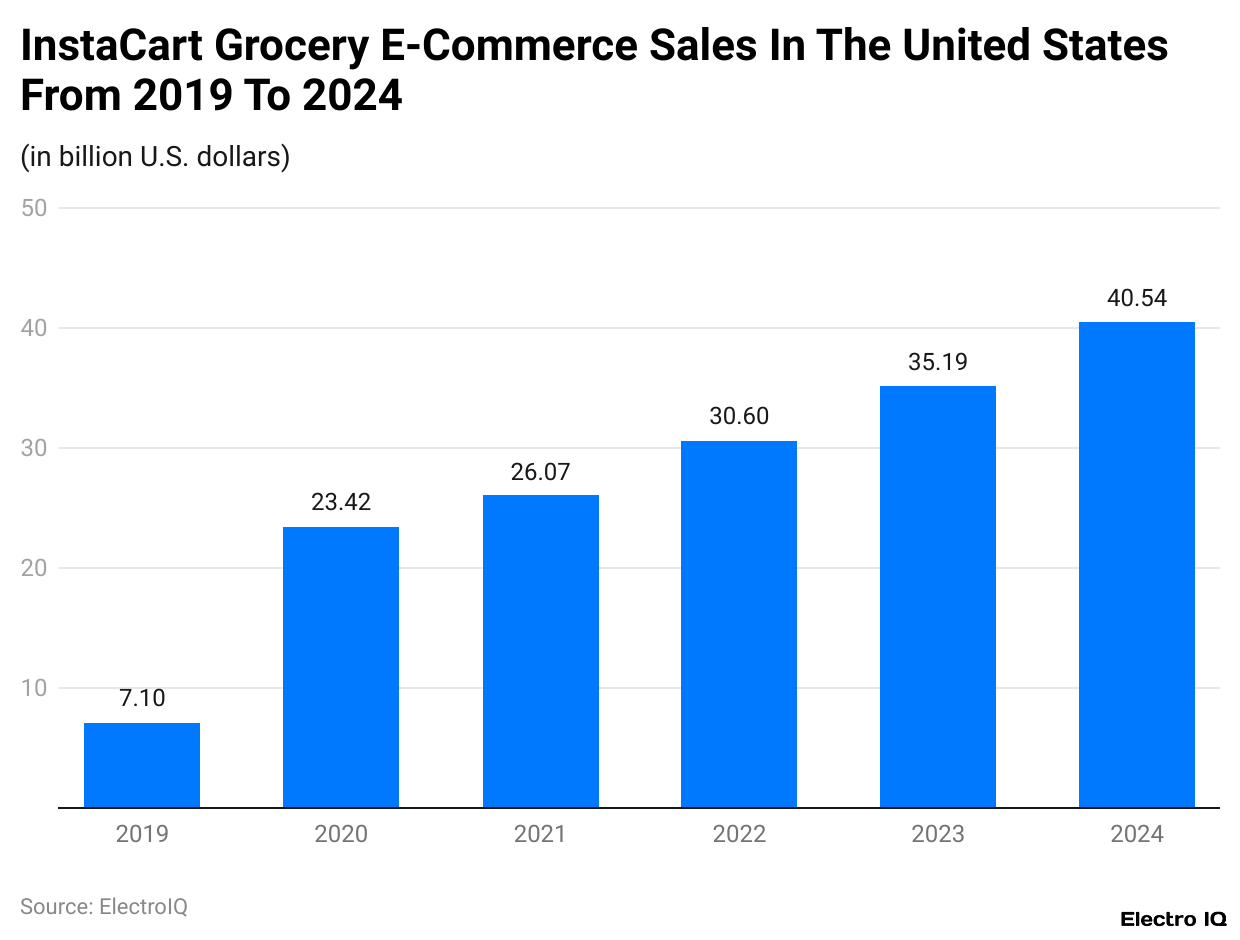
(Reference: enterpriseappstoday.com)
- The value of Instacart’s sales instantly began to rise with the adoption of the new safety measures, as the public resorted more to the grocery shopping offered online.
- In the span of one year, and with an additional US$16.71 billion, sales soared from roughly US$0.71 billion to US$23.42 billion, revealing how much demand amplified with the cessation of physical shopping.
- By 2024, Instacart is expected to pull in US$40.54 billion, showing just how quickly it has grown in the last few years.
- This growth enabled the company to leap into the spotlight and emerge as a leading contender in the grocery delivery battle.
- The pandemic provided a unique opportunity for companies that served groceries online, and Instacart definitely capitalised on that.
InstaCart Order
| Year |
Orders (mm)
|
| 2021 | 223 million |
| 2022 | 262 million |
| 2023 | 269 million |
| 2024 |
294 million (Updated 6th May 2025)
|
| 2025 (Estimated) | 312 million |
(Source: prioridata.com)
- For the past several years, the number of orders placed on Instacart has been on a consistent upward trend, indicating steady demand for grocery delivery.
- The company completed 223 million orders in 2021, which increased to 262 million orders in 2022. This was followed by a slower growth in 2023, when the total orders came in at 269 million.
- The growth rate accelerated once again in 2024 when Instacart completed 294 million orders, and it is expected to grow even further to 312 million orders in 2025.
- This consistent growth demonstrates the increasing number of repeat customers Instacart is gaining, along with the greater role it is assuming in the online grocery space.
InstaCart Partners
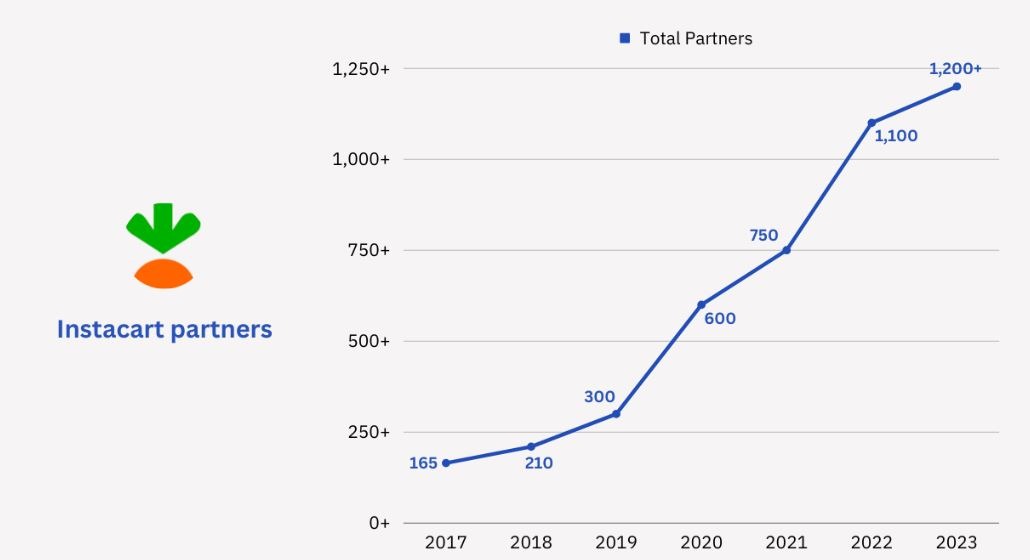
(Source: prioridata.com)
- By joining forces with leading grocers like Costco, Kroger, Safeway, Albertsons, Publix, and Whole Foods, Instacart has made a name for itself.
- Its customers can browse and buy groceries online and have them dropped right at their doorstep.
- The list of retailers has continued to grow over the years. Instacart served 165 partners back in 2017. It grew to 210 in 2018 and 300 in 2019.
- The partnerships swelled to 600 in 2020 and further increased to 750 in 2021.
- In 2022, Instacart gained over 1,100 retail company partners, marking a 45% increase over the last year.
- That number grew further to over 1,200 in 2023, representing approximately 80,000 stores throughout North America.
- This growth is indicative of how Instacart has established itself as a pivotal technology and delivery partner for the majority of the biggest grocery chains, enabling the company to scale nationally and offer customers a broader selection to shop from.
InstaCart Valuation
- Instacart’s valuation has changed markedly in the last decade, reflecting changes in investor confidence, broad market cycles, and the demand for online grocery delivery.
- Back in 2016, the company’s value stood at US$2 billion, which then grew to US$3.4 billion in 2017 and reached US$7.6 billion in 2018 as its business continued to grow.
- The most dramatic increase came in 2020 during the pandemic, when Instacart’s value soared to US$13.7 billion as the demand for grocery delivery skyrocketed.
- That same growth continued in 2021, where Instacart’s valuation reached its all-time high of US$39 billion.
- Afterwards, slowing growth and market corrections made the outlook worse.
- Instacart’s valuation fell to US$24 billion by 2022, and in 2023, it fell again—this time to only US$9.3 billion.
- It slightly decreased again in 2024 to US$8.9 billion, with projections in 2025 placing the valuation at US$8.4 billion.
- While this highlights the incredible growth Instacart experienced during the pandemic, this trajectory showcases the adjustment to increased competition and changes in investor sentiment.
Conclusion
Instacart Statistics: Instacart has demonstrated strong growth in the United States and Canadian online grocery markets. Collaborating with more than 1,200 retailers has helped the company grow, in addition to their subscription service, Instacart+, and their advertising service.
This has enabled them to grow while maintaining profitability. Though there is a dip in the company’s valuation that can be attributed to market conditions, the steadily growing user base and consistent order volume point to ongoing demand. As mankind lies in battle for Instacart, its sharpened focus lies on customer loyalty, innovation, and strategic growth, which will maintain its leadership and growth in the grocery delivery industry.
FAQ.
In 2024, Instacart’s advertising revenues are projected to surpass US$1 billion for the first time, reaching US$1.18 billion, a 25.5% increase from 2023. From 2021 to 2025, ad revenues are expected to increase by US$900 million, or 163.6% overall, with an average growth rate of 27.5% per year.
The number of users on Instacart has increased consistently from 3.3 million in 2017 to a projected 14.9 million in 2025. It indicates the growth of the platform in the US and Canada. In the later years, the growth of users has slowed and continues to grow at a slower pace.
Instacart handles nearly 258 million orders each year, or around 9 orders each second. The annual orders have increased from 223 million in 2021 to a projected 312 million in 2025, which indicates the platform’s strong and steady usage.
In 2023, Instacart works with notable grocery retailers such as Costco, Kroger, Safeway, Albertsons, Publix, and Whole Foods. Instacart serves more than 1,200 retail companies and 80,000 stores. In the grocery delivery niche, Instacart faces competition not only from Amazon Fresh and Walmart but also from Shipt, DoorDash, and Uber Eats. In addition, stricter competition is posed by the subscription-based loyalty programs of Walmart+ and DashPass.
Instacart’s valuation reached its peak of US$39 billion in 2021 during the pandemic, then it dropped to US$8.9 billion in 2024 and is forecasted to fall to US$8.4 billion in 2025. Instacart still grows through its subscription model, grocery advertising, and retail partnerships. Instacart is still profitable and growing its market share.

I hold an MBA in Finance and Marketing, bringing a unique blend of business acumen and creative communication skills. With experience as a content in crafting statistical and research-backed content across multiple domains, including education, technology, product reviews, and company website analytics, I specialize in producing engaging, informative, and SEO-optimized content tailored to diverse audiences. My work bridges technical accuracy with compelling storytelling, helping brands educate, inform, and connect with their target markets.










